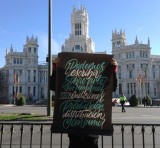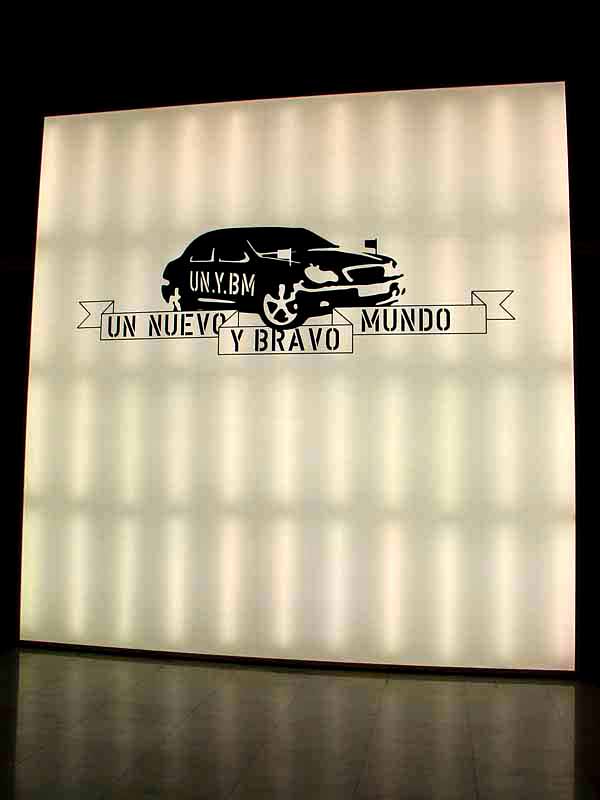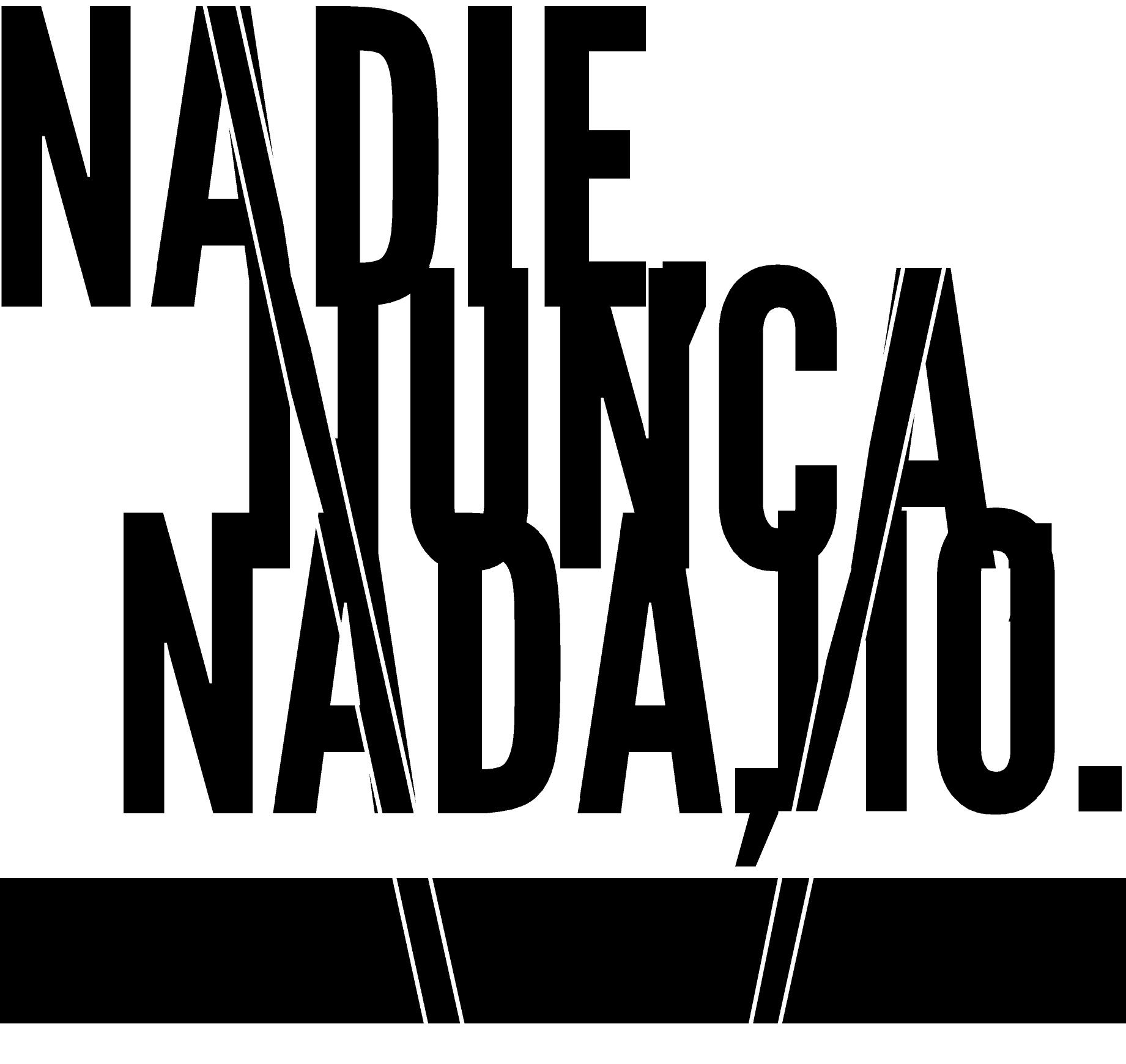Portfolio
- 7.291
- Tapiz 2024
- 21.759
- CRISIS?
- X
- Y
- Z
- Fortaleza Europa
- Horizonte de sucesos
- Las Improbabilidades Infinitas II
- Las Improbabilidades Infinitas
- Resistencia III
- Resistencia II
- R de resistencia
- Ne Travaillez Jamais
- Alguien Ahí
- El Gen Rojo
- Herramientas de Construcción Nacional I
- Juarez Sound System
- Un Pais Un Ejercito
Links
R de resistencia
ENGLISH BELOW
Parece que en la actualidad, el binomio realidad-tiempo que vivimos como presente, se empeña en mostrarnos que no hace falta entender de mecánica cuántica para saber lo qué es un agujero de gusano, lo que significa que el espacio, y especialmente el tiempo, se puedan plegar sobre sí mismos. La actualidad nos enfrenta a ello constantemente.


Espuma de poliuretano, tubería de oleoducto y madera, 190 x 600 x 80 cm, 2018
Polyurethane foam, oil pipeline tubing, and wood, 190 x 600 x 80 cm, 2018
Mientras Hitler planificaba un nuevo mundo que orbitara alrededor de la capital nazi e ideaba la solución final en 1934, Albert Speer proyectó la construcción de la terminal de pasajeros del Aeropuerto de Tempelhof como parte del plan para la reconstrucción de Berlín: “La madre de todos los aeropuertos” según Norman Foster, y la edificación más grande del mundo hasta la inauguración del Pentágono en Washington. Si bien este aeropuerto no tuvo un protagonismo militar importante en la Segunda Guerra Mundial, de sus sótanos salieron los motores de los Stuka que bombardearon Europa en ese momento.
Irónicamente, o como fruto cuántico de un agujero de gusano de la historia reciente, la terminal –cerrada al público en 2008– ha sido habilitada para acoger a los refugiados que han llegado masivamente a Alemania.
Estas personas proceden principalmente de Siria, arrojados por una fallida “primavera árabe”, aunque también de otros países de Oriente Próximo y África. Se han dado momentos en los que llegaban a Berlín 16.000 refugiados al día. A lo largo de 2015, el año más duro desde el inicio del conflicto sirio, Frontex (la institución europea encargada de la gestión de las fronteras) anunció que podrían haber llegado a Europa más de 1.800.000 migrantes de manera irregular.
Puede parecer que el problema de Europa está en la presión migratoria y, de hecho, desde los medios de comunicación y los lobbies que los sostienen se nos muestra insistentemente esta parte de la ecuación como el problema en sí mismo. Pero en realidad son las causas que fomentan esta pulsión las premisas que habría que contemplar a la hora de hacer un análisis de la situación. Y es precisamente ahí donde encontraremos otro extremo del agujero de gusano: allí siempre hallaremos la frase de Carville para la campaña de Clinton “¡es la economía, estúpido!”, trabada con una buena colección de materias primas: guerra-comercio de armas, energía-petróleo-gas, Estado-territorio, religión-poder, tiempo-materia-energía.
Podemos ser más precisos, claro: la construcción de un gasoducto desde Qatar hasta Europa para romper la dependencia energética europea de Rusia, cuyo trazado atraviesa Arabia Saudí, Jordania, Siria y Turquía, es para numerosos analistas la causa última de la guerra de Siria, más allá de la “primavera árabe”. Qatar, aliada estratégica de Estados Unidos en la región, posee la mayor reserva de gas del mundo junto con Irán –cuyo gobierno no puede comercializarlo por las sanciones internacionales–, pero exportarlo por vía marítima es mucho más costoso que construir un gasoducto, algo que aumentaría sin duda los potenciales beneficios.
Por otro lado, la Unión Europea consume casi el 70 % del gas que exporta Rusia y ve con buenos ojos no depender de un sólo proveedor al que no puede presionar lo suficiente. Por supuesto, nada es tan simple, pero justo en medio de esta tormenta perfecta, somos testigos de una guerra enquistada durante años en territorio sirio que ha provocado la huida masiva de millones de ciudadanos.
Y éste es sólo un frente, podríamos continuar analizando buena parte de las causas últimas que empujan a todos aquellos que se sienten perseguidos, en peligro personal o para su familia, o ven imposible vivir en paz o llevar una vida normal, y no acabaríamos nunca. Pero la realidad es ésta: que hay que huir, que hay que salir y dejar atrás tu tierra, tu país, tu familia y tus amigos para llegar a un lugar seguro que pueda convertirse en promesa de una nueva vida.
Para atajar esta situación en septiembre de 2016 el Consejo de la Unión Europea aprobó la nueva normativa para la puesta en marcha de la Agencia Europea de Guardacostas y Fronteras. Una fuerza de intervención rápida con capacidad para actuar en cualquier país de la Unión Europea con el objetivo de salvaguardar sus fronteras y defenderlas de la presión migratoria. Ha sido puesto en marcha en octubre de ese mismo año con el apoyo de Alemania, Francia, Italia y España como sus principales impulsores aunque también ha despertado notable interés en países pertenecientes al área Schengen como Noruega, Islandia o Suiza.
La situación creada a los migrantes como asilados sin estatus de asilados legalizado, los ha convertido en refugiados, desplazados, sin apenas derechos legales, perdidos en el limbo de la legislación internacional, prisioneros de su propia situación sin capacidad para cambiarla.
Así, si los refugiados son los nuevos prisioneros, los campos de refugiados, creados improvisadamente para acogerlos se han convertido en las nuevas cárceles, en las nuevas prisiones, el lugar donde habrán de pagar una pena de tiempo y privaciones por ser quienes son y venir de donde vienen.
La creación de campos de refugiados es una disciplina bien conocida para instituciones como la ONU y a pesar de ser por definición espacios de asentamiento temporal, muchos se construyeron con ese objetivo pero llevan décadas abiertos, facilitan la entrada de personas en situación de vulnerabilidad y peligro y su salida de esta situación y de estos espacios resulta mucho más complicada y se alarga en un tiempo suspendido en la indefinición.
Si bien, los campos de refugiados no son campos de concentración, ni cárceles o espacios de privación de libertad por definición, las penurias a las que se ven sometidos quienes los habitan, las condiciones de vida que en ellos se dan y los peligros implícitos, nos colocan en una situación, como sociedad que los sostiene, más que cuestionable.
Primo Levi, recluido y torturado en Auschwitz, diría años después: «Sí, cuando fui liberado, lo que dominaba era la vergüenza de ser un hombre […] Esto no significa que los verdugos y las víctimas sean los mismos” Sobre esto, en su Abecedario videográfico Gilles Deleuze le responde a Claire Parnet: «Yo creo que en el origen del arte encontramos esa idea, o ese sentimiento muy vivo de una cierta vergüenza de ser un hombre, que hace que el arte consista en liberar la vida que el hombre ha encarcelado. El hombre no deja de encarcelar la vida, no deja de matar la vida. La vergüenza de ser un hombre: el artista es aquel que libera una vida, una vida potente, una vida que es más que personal, que no es la propia vida.”
ENGLISH TEXT
It seems that nowadays our reality, so tightly interwoven with the space-time binary, insists on showing us that you don’t have to understand quantum mechanics to recognize a wormhole, where space, and especially time, can fold in on itself. In fact, our present reality constantly confronts us with such wormholes.
While Hitler was planning his Nazi-founded new world 1934, Albert Speer was planning the construction of the Tempelhof Airport as part of the reconstruction of Berlin. It was the “Mother of all airports,” according to Norman Foster, sitting as the largest building in the world until the inauguration of the Pentagon in Washington D.C. While the airport didn’t play any important military role in World War II, the Stuka engines that bombed Europe at the time came out of its basements.
Ironically, or as the quantum fruit of a recent historical wormhole, the previously closed airport terminal has been given new life, welcoming refugees who have arrived en masse in Germany. These refugees are people who come mainly from Syria, expelled by a failed “Arab Spring,” but also come from other countries around the Middle East and Africa. There have been times when as many as 16,000 refugees were arriving in Berlin every day. Throughout 2015, the toughest year since the start of the Syrian conflict, Frontex (the European institution in charge of border control) announced more than 1,800,000 migrants may have arrived in Europe through various means.
It may seem that Europe’s problem lies in migratory pressure, not only as a result of these numbers, but of the media and lobbies that incessantly portray migration as the problem itself. In reality, we should be considering the root causes of these migration patterns, rather than seeing the patterns alone as the issue. And it is precisely there that we find the other end of the wormhole: aid best by Carville’s slogan for the Clinton campaign, “it’s the economy, stupid!” The economy with a stockpile of raw materials: war/arms trade, energy/oil/gas, state/territory, religion/power, time/matter/energy.
We can be more precise, of course: take the construction of a gas pipeline from Qatar to Europe to break Europe’s energy dependence on Russia, one whose route crosses Saudi Arabia, Jordan, Syria, and Turkey. This, for many analysts, is the ultimate cause of the Syrian war, beyond just the Arab Spring. Qatar, a strategic regional ally of the United States, has the largest gas reserves in the world along with Iran, whose government cannot market it because of international sanctions. When you build a pipeline, you undoubtedly increase potential profits, without having to worry about the high cost of exporting oil by sea. On the other hand, the EU consumes almost 70% of the gas exported by Russia, and sees it as a good thing not to depend on a single supplier, especially one who remains immovable by European pressure. While nothing is so simple, this perfect storm is where Syria has been ingrained for years, causing the mass migration of millions of citizens.
And this is just one side of the issue, we could analyze all of the causes that push out those who feel persecuted, in personal danger, fear for their families, or find it impossible to live in peace or to lead a normal life, but we would never finish. The reality is that you have to flee, you have to leave your land, your country, your family, and your friends behind in order to reach a safe place, one that can become the promise of a new life.
To address the situation, the Council of the European Union approved new regulations in September of 2016 for the implementation of the European Border and Coast Guard Agency, a rapid intervention force with the capacity to act in any EU country with the aim of safeguarding its c\borders and defending them from migratory pressure. It was launched that October with the key support of Germany, France, Italy, and Spain. It had also aroused considerable interest in Schengen Area countries: Norway, Iceland, and Switzerland.
For migrants without legal asylum seeker status, these regulations have turned them into refugees. They lack legal rights, lost in the limbo of international legislation, and prisoners of their own situation without any agency to change it.
Thus, if refugees are the new prisoners, then the impromptu refugee camps are the new jails. They are new prisons where the crimes are of identity and national origin, and the punishments are time and deprivation.
The creation of refugee camps is a well-known behavior of institutions like the UNA. Despite being temporary settlements by definition, many were built to last for decades. They become the infrastructure that facilitates vulnerable people, delaying their exits indefinitely, as if time itself were suspended.
Although refugee camps are not concentration camps nor prisons by definition, the hardships to which their inhabitants are subjected, their living conditions and implicit dangers, put us in a highly questionable position as a society that sustains them.
Primo Levi, having been imprisoned and tortured in Auschwitz, would say years later tha “when I was liberated, what dominated was the shame of being a man… [but] this doesn’t mean that the executioners and the victims are the same.” About this statement, Abecedary Gilled Deleuze responds in a video to Claire Parnet that “I believe that at the origin of art we find this idea, or this very vivid feeling of a certain shame of being a man, which makes art consist in liberating the life that man has imprisoned. Man does not stop imprisoning life, he does not stop killing life. The shame of being a man: the artist is the one that liberates life, a powerful life, a life that is more personal, that is not life itself.”



